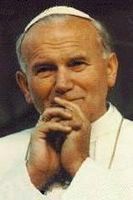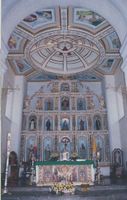The following is the first travel piece I've written, which was published in the Philippine Graphic magazine in July 2004. It's about the Turumba Festival, celebrated in the summer in the town of Pakil, located in Laguna, a province in Luzon just south of Manila. I'm quite proud of this piece, proud enough to post it here. My apologies for not having the scanned pictures to accompany it; I may provide them in the future. If you happen to be a foreigner, I hope my work allows you to glimpse another side of the Philippines, a cheerful, more festive side. Read on and enjoy!
THE 2004 TURUMBA FESTIVAL: DANCING FOR THE DOLOROSA
There’s no doubt we Filipinos have an irrepressible and innately festive spirit, and the countless fiestas we celebrate all over the country certainly confirm this. Few could match the dedication and the passion that we show at these fiestas. In turn, these fiestas, particularly those held in the summer, turn us into a nation of pilgrims. Consider all those people who travel to Antipolo and pray to Nuestra Señora dela Paz y Buen Viaje; or to Lucban, Quezon to take part in the Pahiyas and honor San Isidro Labrador. Clearly, faith is often at the center of these festivities.
It’s quite startling how often we rely on that faith, and the pilgrimages we undertake offer proof of that faith in action. Some embark on a pilgrimage to ask for a favor, to seek help; others do so for a prayer answered, a request granted or a vow sworn. Indeed, pilgrimages can transform us. They also offer us a chance to discover what is unknown, to find what is lost.
These thoughts had crossed my mind that morning, while on my way to Pakil, Laguna to attend its annual Turumba Festival. This particular festival, held in honor of Nuestra Señora de los Dolores, consists of seven specific days, spanning the whole summer. Each day commemorates one of the seven sorrows of the Virgin Mary, and the town was honoring the third one—her search for Jesus for three days before she and Saint Joseph found him in the temple—when I arrived. Consequently, this festival, which the Pakileños refer to as the Pistang Lupi (lupi means “to fold up”), holds the distinction of lasting the longest among all the other fiestas in the country.
One of Pakil’s most revered residents, town historian Iñigo G. Vito, once said that the third day of the festival, called the Pistang Biyatiko (biyatiko refers to food packed or provisioned for a journey), often attracted the most number of devotees to Pakil. He was right: the street leading up to the town plaza teemed with people. Vendors lined up the street on each side, trying to lure passersby to check out their products—food, clothes, refreshments and religious items, even paper-maché horses. Most bought refreshments; the morning had already begun to heat up.
The town swimming pool, the Panghulo, also teemed with people. For a relatively small fee, one could bathe in one of two pools (one for adults, the other for children) filled with cool and clean spring water gushing from a large metal pipe connected to a nearby mountain. It’s quite easy to see why people flock to the Panghulo, and it’s not just because of the stinging heat. Many believe the spring water has curative value, and the faithful that had lined up towards a running faucet just outside the Panghulo to fill their plastic containers with it attest to this belief.
Crowded as the Panghulo was, it paled to the throng of devotees that had gathered at the church to attend Mass. Recent restoration efforts have permitted the San Pedro de Alcantara Church to recapture most, if not all of its original splendor, and all that hard work has turned this house of God into one of the most beautiful I have ever seen. Its façade is remarkable, and so are its interiors—the alternating, almost-perfect rows of brick and stone; the quietly compelling “Judicium Finale (Final Judgment)” hanging at one side of the church, towering over the congregation; the ceiling expertly painted with Biblical scenes; the polished white-and-gold retablos.
However, none commanded more attention than the Lady of Sorrows, waiting at one of the side retablos. She looked every inch a queen, even in her anguish—her dark blue mantle and maroon gown, embroidered with glinting gold threads that formed floral patterns; the iridescent jewelry adorning her image; the oval of rays around her face; the halo of stars around her head. Moreover, her flower-decked silver carroza reinforced her majestic appearance. Men in light blue shirts surrounded the carroza, ready to hoist it over their sturdy shoulders at any time.
That time came soon enough, as they carried the carroza and the image on it through the side entrance, carried it out of the church and into the plaza, where thousands had gathered, expecting, waiting. Then it began: the Dolorosa, ever slightly, began to sway back and forth, as though riding on a boat sailing through unsteady waters. Then the sea of devotees lifted their arms and began to wave them in all directions, like ocean tides. Like what their ancestors did more than two centuries ago, clapping and dancing, shouting and singing as they trailed behind a priest carrying an oil painting of Our Lady of Sorrows, which no one before had been able to lift after it had surfaced, mysteriously unharmed, from the deep waters of Laguna Bay.
But that’s not all. As the image proceeded to complete her route around the church, her followers started to sing a song, a song pilgrims had already learned by heart:
Turumba, turumba Mariangga
Matuwa tayo’t magsaya
Sumayaw ng Tuturumba
Puri sa Birhen Maria
Turumba, turumba sa Birhen
Matuwa tayo’t mag-aliw
Turumba’y ating sayawin
Puri sa Mahal na Birhen
Biyernes nang makita ka
Linggo nang iahon ka
Sumayaw ng Tuturumba
Puri sa Birhen Maria
Turumba, turumba sa Birhen
Turumba, turumba sa Birhen
Turumba’y ating sayawin
Puri sa Mahal na Birhen.
It didn’t took that long for the Virgin to finish her route and return to the plaza, where a crowd had already assembled to welcome her back. It had already doubled its original size by the time Rev. Mgsr. Jose Barrion, the parish priest of Pakil, ascended the town stage to close—or fold up, if you will—the Pistang Biyatiko by blessing the image with incense and holy water. Afterwards, the devotees started to mill around the carroza, eager to grab a flower or wipe a part of the glass case holding the image with their handkerchiefs or face towels—and many of them were able to do so. It was virtual pandemonium. But town officials immediately restored order, and it stayed that way as the Dolorosa retraced her steps and retreated to the church as the choir onstage, and some of the devotees, sang the “Salve Regina.” A few even waved goodbye.
By noon it was all over: the crowd in front of the town stage had already dispersed, the pilgrims went on their separate ways, several vendors had already removed their goods and folded up, a handful remained inside the church, and a sudden hush fell over the town.
All the places I had visited in Pakil, all the people I had observed there—they engaged my mind on my way back to Manila. It’s quite astonishing, if you think about it: the things that we do for our faith, what it stirs in us. Indeed, faith—specifically, faith in God—is a powerful force. It can sustain somehow, it can remain constant, even if our faith in Man does not. And in a time when that faith in Man falters more than usual, that’s a reassuring thought. (Copyright © 2004 by A.I.D.)





